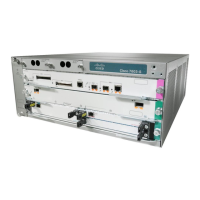5-62 Cisco 7010 Hardware Installation and Maintenance
Installing and Configuring Processor Modules
E1 Configuration
The following steps describe a basic E1 configuration. Press the Return key after each step.
Step 1 At the privileged-mode prompt, enter the configuration mode and specify that the console
terminal will be the source of the configuration subcommands as follows:
Router# conf t
Enter configuration commands, one per line. End with CNTL/Z.
Router(config)#
Step 2 At the prompt, specify the controller to configure by entering the subcommand cont,
followed by e1, and slot/applique (interface processor slot number/applique). The example
that follows is for the MIP in interface processor slot 4, applique 1:
Router(config)# cont e1 4/1
Step 3 At the prompt, specify the framing type.
Router(config-controller)# framing crc4
Step 4 At the prompt, specify the linecode format.
Router(config-controller)# linecode hdb3
Router(config-controller)#
%CONTROLLER-3-UPDOWN: Controller E1 4/1, changed state to up
Router(config-controller)#
Step 5 At the prompt, specify the channel-group modification command, channel-group and
timeslots to be mapped. The example shows channel-group 0 and timeslots 1, 3 through 5,
and 7 selected for mapping.
Router(config-controller)# channel-group 0 timeslots 1,3-5,7
Router(config-controller)#
%LINEPROTO-5-UPDOWN: Line protocol on Interface Serial4/1:0, changed state to down
%LINEPROTO-5-UPDOWN: Line protocol on Interface Serial4/1:0, changed state to up
Router(config-controller)#
Router(config-controller)#
Step 6 At the prompt, specify the interface, serial, slot, applique, and channel-group to modify.
Router(config-controller)# int serial 4/1:0
Step 7 At the prompt, assign an IP address and subnet mask to the interface with the ip address
configuration subcommand as in the following example:
Router(config-if)# ip address 1.1.15.1 255.255.255.0
Router(config-if)#
Step 8 Add any additional configuration subcommands required to enable routing protocols and
adjust the interface characteristics.
Step 9 After including all of the configuration subcommands, and to complete the configuration,
enter Ctrl-Z (hold down the Control key while you press Z) to exit the configuration mode.
Step 10 Write the new configuration to memory as follows:
Router# write memory
The system will display an OK message when the configuration is stored.

